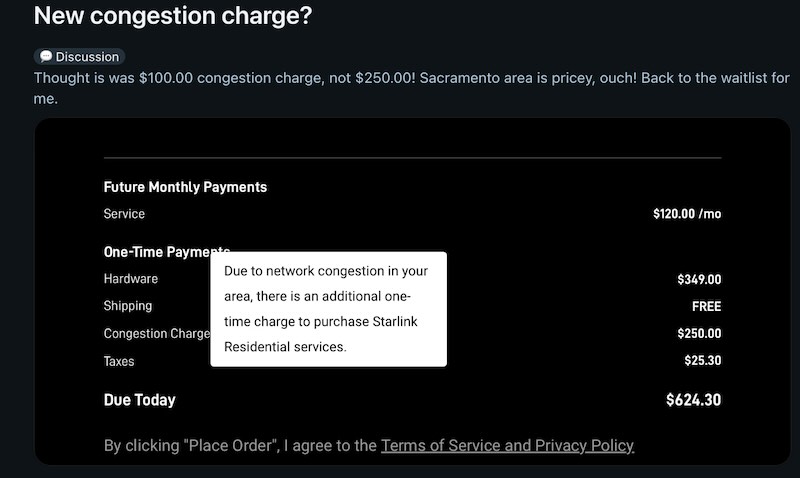SpaceX has quietly increased the one-time “congestion charge” for new Starlink subscribers from $100 to $250 in several high-demand US markets. Price adjustment comes as the company transitions certain regions from waitlists to immediate availability, albeit at a premium price point.
The increased fee affects potential customers in Sacramento, San Diego, Phoenix, and central Florida – areas previously restricted by waitlists. For residents in these locations seeking reliable high-speed internet, the path to Starlink connectivity just became significantly more expensive.
A frustrated potential customer shared their experience on Reddit: “Thought it was $100.00 congestion charge, not $250.00! Sacramento area is pricey, ouch! Back to the waitlist for me.”

A frustrated potential customer shared their experience on Reddit
Another user confirmed the change, noting that SpaceX has “eliminated waitlists in Sacramento, San Diego, Phoenix, and central Florida but started to charge a higher congestion fee in these areas.”
The strategy appears straightforward – SpaceX is allowing immediate access to previously capacity-constrained markets, but only for those willing to pay a substantial premium. Approach potentially benefits rural customers with limited internet alternatives while generating additional revenue for Starlink’s network expansion.
SpaceX introduced congestion charges last year to address network strain in high-demand regions. The fees represent one of several strategies the company has deployed to manage Starlink’s growing subscriber base.
Other capacity management tactics include:
Speed caps and usage restrictions
Subscribers on certain plans now face speed limitations during periods of network congestion. Additionally, Starlink has threatened to block Roam customers who use the service in “sold out” areas for more than two months.
Variable pricing approach
Not all markets face higher fees. The congestion charge remains $100 in cities like San Francisco, Las Vegas, and Orlando. Meanwhile, SpaceX offers significant discounts in regions with abundant network capacity through its “regional savings” program, which can reduce equipment costs from $349 to $149.
Installation incentives
In select US states, SpaceX provides free or discounted professional roof installations for Starlink dishes, further indicating the company’s flexible approach to regional market dynamics.
The Starlink network continues to expand with regular satellite launches, but demand growth appears to be outpacing capacity additions in urban and suburban areas. For rural customers with few alternatives, even the increased $250 congestion fee may represent reasonable value compared to limited options from traditional ISPs.
SpaceX hasn’t officially commented on the price increase, leaving customers to navigate the changing cost landscape without explanation. As the Starlink constellation continues to grow, SpaceX is looking to match its initial request for nearly 30k Gen2 satellites, these pricing strategies highlight the challenges of scaling a satellite internet system amid skyrocketing demand.
Related Post
SpaceX New Starlink Dish to Deliver Gigabit Internet Speeds, Rivaling Fiber Networks
SpaceX V3 Starlink Satellites: 20x More Powerful Than Previous Generation, Launch on Starship
SpaceX Texas Starlink Terminal Manufacturing Facility in Bastrop: Makes 4.7M Terminals Per Year
